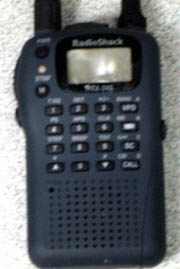If the Internet has spawned a host of demonic personas hacking personal computers and spreading data-cidal viruses, ham radios have engendered an angelic coalition of do-gooders who want to help.
At the same time, ham radio enthusiasts love to share knowledge and trade secrets with fellow hobbyists. When people receive a phone call from someone they don’t know, they generally hang up. But when a ham radio enthusiast receives a transmitted message from an unknown source, everything is running smoothly.
These wave frequency know-it-alls enjoy using communication technology to reach new people as opposed to talking to those they already know.
That is why Richard Krajewski, a Jersey City resident, is resurrecting the defunct Jersey City Amateur Radio Club that will provide Hudson County with a volunteer back-up unit of radio operators in case a communications breakdown occurs during an emergency.
"The biggest problem that we’ve had in Hudson County for many years is that there wasn’t an amateur radio component to emergency back-up plans," said Bob Sirri, the county co-coordinator of the Hudson County Radio Amateur Communications Emergency Services.
Many times local communications networks are affected by natural disasters, like September 1999, when Hurricane Floyd crippled communications in Northern New Jersey. Bob Cirri recalls the difficulties that different emergency units had in contacting one another at the time. Amateur radio clubs train for these situations so, stationed in a place with working equipment, they can receive messages from one unit and transmit them to another.
Due to the World Trade Center collapse, the JCRA found an opportunity to chip in again sooner than it expected. Krajewski said the American Red Cross requested its services on Sep. 11 when the World Trade Center was attacked. John Hunter, Stanley Daniels and Mike Janeczko, all members of the club, established a VHF radio station at the Red Cross building in Jersey City. "They built and raised an antenna above the building," Krajewski said, "which they connected a 50-watt transceiver." This system allowed them to make contact with the emergency communications networks of neighboring counties and to pass emergency messages to the disaster site in New York City.
On Sept. 13, the club had met for the first time at the Red Cross building at 26 Greenville Ave. to discuss its plans to create such a back-up unit. Through the assistance of Sirri, the Red Cross donated space for the club to use as well as equipment to facilitate its back-up plan. According to Krajewski, the emergency back-up unit should be ready after a few months of training. "We’ll probably start having our first on-the-air drills in three months," he said.
According to Krajewski, 55, the JCRA was launched in the 1950s and remained active until the 1970s, when interest faded. "I got my radio license through that club back in 1970," he said. "I turned out using that experience to guide my career choice."
Krajewsi is an electrical engineer. Gaining some free time recently, he was able to pursue his longtime hobby a bit further.
Finding interested members on the airwaves and contacting ham radio enthusiasts that have registered with the American Radio and Relay League, Krajewski expects 15 Jersey City residents to attend the meeting. Seven months ago, he met Frank Murray, proprietor of Murray’s Funeral Home in Jersey City, over the airwaves. Murray, who has been tinkering with amateur radios for the past 10 years, was eager to join the club from the time Krajewski presented the idea. "I hope that this new club will take off," Murray said.
According to the ARRL, there are 155 licensed amateur radio operators in Jersey City. In addition to the emergency back-up unit, Krajewski wants the club to assist ham radio fledglings in learning the craft of surfing radio waves and obtaining the necessary licenses to practice.
The Federal Communications Commission requires all ham radio operators to take standard written tests before sending messages, unless the messages are monitored by a licensed operator. The club already has three Volunteer Examiners, people who can administer the entry-level test. The FCC created three classes of operators, which include a Technician’s license, a General’s license, and an Extra Class license. The Technician’s license allows a ham radio operator to do most activities, Krajewski said. The higher classes allow the operator to use broad range of low frequencies that are slightly less powerful than AM bands.
Krajewski plans on recruiting more members and hopes that the club will spark interest among the city’s youth. "Getting a ham radio license is usually an impressive thing on a college resume," Krajewski said. He added that many young people who enter the world of ham radios often discover a new set of career paths that interest them.
In an effort to recruit students, Murray said, the club is seeking the Board of Education’s permission to post up notices of the meeting in the city’s high schools. There is no cost in becoming a member.
"Jersey City seems to be a city with a wide strata of economic levels, and I think it should be open to people," he said.
